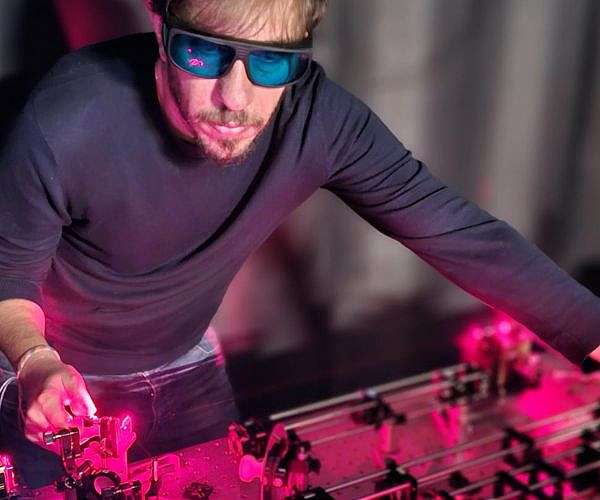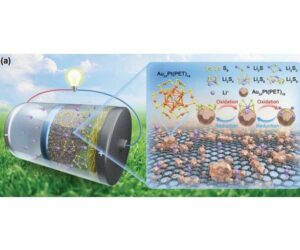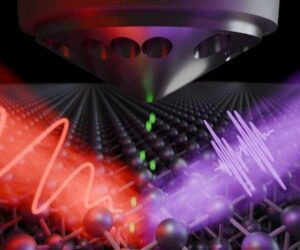
by Robert Schreiber
Berlin, Germany (SPX) Dec 04, 2023
Researchers at Ludwig Maximilian University of Munich (LMU) have made a significant leap in solar energy technology, developing high-performance nanostructures that set a new world record in green hydrogen production using sunlight. This groundbreaking work, detailed in a publication in Nature Catalysis, opens up new avenues for solar cells and photocatalysts.
Leading the research, Professor Emiliano Cortes of experimental physics and energy conversion at LMU, has taken a novel approach to harnessing solar energy. Diving into the nanocosmos, Cortes and his team at LMU's Nano-Institute have been working diligently to create material solutions for more efficient use of solar energy. "Where the high-energy particles of sunlight meet atomic structures is where our research begins," Cortes states, emphasizing the innovative direction of their work.
The team's focus has been on overcoming the challenge of Earth's 'diluted' sunlight, which presents a lower energy per area. Traditional solar panels address this by covering large areas, but Cortes' approach is different. With the support of the e-conversion cluster of excellence, Solar Technologies go Hybrid initiative, and the European Research Council, the LMU team has developed plasmonic nanostructures that concentrate solar energy more effectively.
One of their most notable achievements is a two-dimensional supercrystal, capable of generating hydrogen from formic acid using sunlight. Dr. Matias Herran, a key researcher in the project, explains, "We create particles from a plasmonic metal, in this case, gold, in the range of 10-200 nanometers. At this scale, the interaction of visible light with the gold's electrons is significantly enhanced." This interaction results in highly localized and strong electric fields, known as hotspots, between the gold particles. Platinum nanoparticles are strategically placed in these interspaces to convert formic acid into hydrogen efficiently.
The efficiency of this process is unparalleled. The supercrystal boasts a hydrogen production rate from formic acid of 139 millimoles per hour per gram of catalyst, currently holding the world record for hydrogen production using sunlight. This breakthrough offers a promising alternative to the traditional hydrogen production methods, predominantly reliant on fossil fuels like natural gas.
Cortes and Herran's innovation not only represents a stride in green hydrogen production but also holds potential for industrial applications, such as converting CO2 into usable substances. The dual integration of plasmonic and catalytic metals marks a significant advancement in the development of potent photocatalysts.
The implications of this research are far-reaching. By enhancing the efficiency of solar energy conversion and opening up new pathways for renewable hydrogen production, this technology stands at the forefront of sustainable energy solutions. The LMU team's work, underpinned by nanotechnology and a deep understanding of photophysics, could pave the way for more effective and environmentally friendly energy systems globally. Their material development has already been patented, signaling a strong confidence in its commercial viability and potential impact on the energy sector.
Research Report:Plasmonic bimetallic two-dimensional supercrystals for H2 generation
Related Links
Center for NanoScience
All About Solar Energy at SolarDaily.com
- SEO Powered Content & PR Distribution. Get Amplified Today.
- PlatoData.Network Vertical Generative Ai. Empower Yourself. Access Here.
- PlatoAiStream. Web3 Intelligence. Knowledge Amplified. Access Here.
- PlatoESG. Carbon, CleanTech, Energy, Environment, Solar, Waste Management. Access Here.
- PlatoHealth. Biotech and Clinical Trials Intelligence. Access Here.
- Source: https://www.solardaily.com/reports/Innovative_supercrystal_material_ushers_new_era_in_solar_energy_efficiency_999.html
- :has
- :is
- :not
- :where
- $UP
- a
- About
- achievements
- address
- advancement
- already
- also
- alternative
- and
- applications
- approach
- ARE
- AREA
- areas
- AS
- At
- atomic
- avenues
- been
- between
- boasts
- breakthrough
- but
- by
- capable
- case
- Catalyst
- Cells
- challenge
- Cluster
- co2
- commercial
- concentrate
- confidence
- Conversion
- convert
- converting
- could
- Council
- covering
- create
- Currently
- dec
- deep
- detailed
- developed
- developing
- Development
- different
- diligently
- diluted
- direction
- diving
- dr
- earth
- Effective
- effectively
- efficiency
- efficient
- efficiently
- Electric
- electrons
- emphasizing
- energy
- energy efficiency
- Energy Solutions
- enhanced
- enhancing
- environmentally
- environmentally friendly
- Era
- Ether (ETH)
- European
- Excellence
- experimental
- Explains
- far-reaching
- Fields
- Focus
- For
- forefront
- fossil
- fossil fuels
- friendly
- from
- fuels
- GAS
- generating
- Germany
- Globally
- Go
- Gold
- Gram
- Green
- groundbreaking
- Harnessing
- Have
- high-performance
- Highlight
- highly
- his
- holding
- holds
- hour
- HTTPS
- Hybrid
- hydrogen
- Impact
- implications
- in
- industrial
- Initiative
- Innovation
- innovative
- integration
- interaction
- into
- ITS
- jpg
- Key
- known
- large
- leading
- Leap
- light
- like
- lower
- made
- material
- Meet
- metal
- Metals
- methods
- more
- more efficient
- most
- Munich
- nanotechnology
- Natural
- Natural Gas
- Nature
- New
- notable
- novel
- of
- Offers
- on
- ONE
- only
- opening
- opens
- our
- overcoming
- panels
- patented
- pathways
- pave
- per
- Physics
- placed
- platinum
- plato
- Plato Data Intelligence
- PlatoData
- potent
- potential
- predominantly
- presents
- process
- Production
- Professor
- project
- promising
- Publication
- range
- Rate
- record
- Renewable
- report
- represents
- research
- researcher
- researchers
- Results
- ROBERT
- s
- Scale
- sector
- set
- significant
- significantly
- solar
- Solar cells
- solar energy
- solar panels
- Solutions
- spx
- stands
- States
- Strategically
- stride
- strong
- structures
- such
- sunlight
- support
- sustainable
- Sustainable Energy
- Systems
- taken
- team
- Technologies
- Technology
- that
- The
- the world
- their
- These
- this
- to
- traditional
- underpinned
- understanding
- university
- unparalleled
- usable
- use
- ushers
- using
- viability
- visible
- Way..
- we
- which
- with
- Work
- working
- world
- zephyrnet












